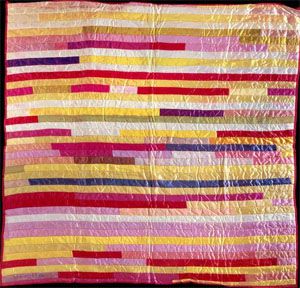The Quilting Tradition of North Carolina
The history of quiltmaking in North Carolina is hundreds of years old and the quilters, mainly women, came from all social and ethnic groups. Women made quilts alone and in groups, for home use and community fundraisers, for everyday use and in honor of special occasions. 1
The first widespread quilting tradition to take root in North Carolina was chintz appliqué or broderie perse (French for “Persian embroidery”). The trend drew upon English quilting traditions and became popular in the mid-Atlantic and southeastern United States during the late eighteenth and early nineteenth centuries. Like whole-cloth quilting, this style was a marker of status, and women made chintz appliqué quilts to showcase their fine needlework skills and abundant free time rather than just to keep warm. Using colorful printed chintz imported from Europe, makers cut out figures from the fabric and arranged them into new patterns and scenes on a white or cream ground cloth. Such quilts tended to be large, thinly batted, and intricately quilted. Common motifs included birds, fruit, and flowers. Large, vinelike “trees of life,” also called palampores after a style of printed Indian cloth, featured prominently in many of these bedcoverings. 2

The advent of the Civil War brought changes to North Carolina’s quilting... Federal blockades and rampant inflation limited access to imported cloth, and local mills shifted to producing fabric for the war effort. Some women turned to home spinning and weaving in order to provide cloth for their families. Naturally, decorative quilting took a backseat to more pressing needs.
Ann Sloan Lowrie Knox of Mecklenburg County sent five of her six sons to fight for the Confederacy. In 1864, two sons were killed in battle. Another died of disease the following year. A fourth perished from lingering wounds shortly after Confederate surrender. To commemorate her family’s overwhelming loss, Knox created a plaid checkerboard medallion quilt using fabric scraps from her deceased sons’ clothing. 2

A major fancywork trend emerged nationally in the final decades of the nineteenth century: crazy quilting. A renewed interest in the needlecraft traditions of early settlers, which emerged during the 1876 national centennial, and a Victorian fascination with orientalism together resulted in a new, purely decorative type of quilting. Crazy quilts featured irregularly shaped bits of fabric—often expensive silks and velvets—stitched together asymmetrically. Frequently makers embellished the seams with fancy herringbone and feather stitches and embroidered or painted decorative motifs like birds, flowers, insects, pagodas, and fans onto their quilt tops. North Carolinians who could afford to do so eagerly adopted the style. 2

By the early 1930s, quiltmaking was surging. Print publications had begun broadly circulating quilt patterns, and fabric was more widely available than ever. No longer did quilting belong to the realm of the affluent. Quite inversely the craft had largely become one of subsistence and making do. North Carolina was a national leader in textile manufacturing, and mill ends, feed sacks, and other types of easily repurposed cloth were readily accessible. Feed companies even began using decoratively printed fabrics for their sacks to attract female consumers who would later turn the bags into garments and quilts. 2

Piecing remained the technique of choice for most twentieth-century North Carolina quilters. The method allowed makers to conserve fabric, and the wide availability of patterns permitted a great number of options. In some circles, the craft declined as families left their rural roots to work in the tobacco and textile mills or World War II–era industries. As people moved to towns and cities and started shopping for their bedcoverings and home furnishings in department stores, some began to view quilting as old-fashioned. Still many North Carolina women continued to make quilts for warmth, beauty, and symbolic functions. 2

And now enjoy this wonderful video where Julia Carpenter visits the Museum of North Carolina Handicrafts in Waynesville, North Carolina in search of antique quilts and coverlets. Housed in the Histroic Shelton House, The Museum of NC Handicrafts offers dozens of quilts and coverlets dating back to the early 19th century.
Credits
1. tobaccofarmlifemuseum.org
2. ncpedia.org
